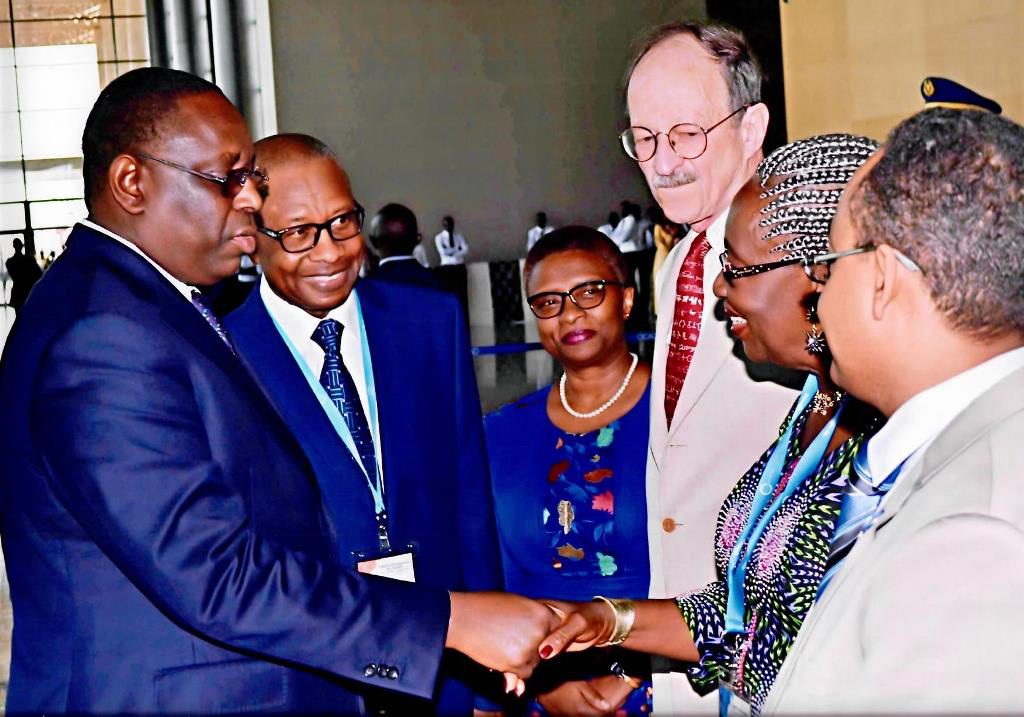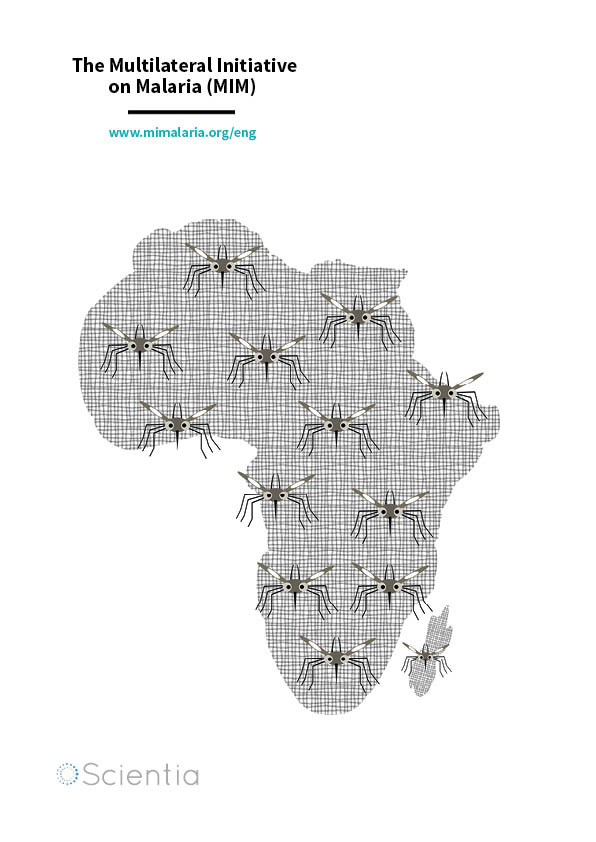The Multilateral Initiative on Malaria (MIM)
Malaria is a worldwide killer. According to WHO statistics, the disease resulted in 445,000 deaths in 2016, with the vast majority (407,000) occurring in African countries. Next year the first ever vaccine against malaria will be tested in a clinical trial in Ghana, Kenya and Malawi. As the outcome of the trial remains uncertain, the need for collaborative research to tackle this devastating disease is stronger than ever.
The Multilateral Initiative on Malaria (MIM) was established in 1997. Through collaborative research and training, MIM’s aim is to strengthen and sustain the capability of malaria-endemic countries in Africa to develop tools and policies for malaria control. In this exclusive interview with MIM’s Executive Director Professor Rose Gana Fomban Leke, we talk to her and her team (including Executive Secretary Professor Wilfred Mbacham and Dr Abanda Ngu) about their achievements and goals for the future in paving the way towards eradicating malaria from Africa.
To begin, can you please tell us briefly about the origins of the Multilateral Initiative on Malaria, your current role, vision and goals for the future?
At its inception, MIM was set up as an alliance of organisations and individuals with four constituents, namely, MIMCom, MR4, MIM/TDR and the MIM Secretariat. Each constituent was hosted and supported by an organisation in the MIM Alliance and performed a specific function to support MIM’s overall mission.
MIMCom hosted at the US National Library of Medicine established fast and reliable internet connectivity at research sites across Africa. The Malaria Research and Reference Reagent Resource Center (MR4) hosted at the ATCC (The Global Bioresource Center) provided malaria research reagents and training to scientists in Africa. MIM/TDR hosted at the WHO/TDR (the Special Programme for Research and Training in Tropical Diseases), received funding from MIM partners, awarded research grants, promoted research partnerships and encouraged collaboration across Africa.
‘Through funds provided by MIM partners, as of 2007, MIM/TDR had supported 69 competitive grants and 56 principal investigators working in 33 institutions in 17 African countries.’

The MIM Secretariat coordinated the activities of MIM and organised the MIM Pan-African Malaria Conferences. The MIM Secretariat rotates within MIM partner organisations and is now based at the Biotechnology Centre of the University of Yaounde I, Cameroon.
I serve as Chair of the MIM Secretariat, our Dutch partner Dr Peter De Vries served, and now Belgian partner Jean Pierre Van Geertruyden of the Antwerp Tropical Institute serves, as vice chair and Professor Wilfred Mbacham is Executive Secretary.
In taking up the reigns of the MIM Secretariat, we were charged with the task of reviewing the objectives of MIM and aligning them with current challenges, consolidating MIM’s successes and achievements and charting the road to the future. In this process, we came up with an eight-point strategic objective.
To establish MIM as a legal entity, to raise funds for new research initiatives, to strengthen the MIM Alliance, to Initiate Public Private Partnership with the Business World, to Improve on African ownership through membership and to continue to strengthen research capacity. In addition to raising the profile of malaria on national agendas through advocacy and enhanced communication and organising the Pan-African Malaria Conferences.
MIM has changed the scientific landscape of malaria research in Africa but the funding landscape has also changed. MIM must adapt to this changing landscape while retaining its fundamental identity to stimulate research on malaria in Africa and to build capacity.

Tell us about how you are working to support scientific research in Africa focused on reducing the health and economic burden of malaria.
MIM’s approach to reducing the health and economic burden of malaria is to stimulate research to develop the tools that can be used for malaria control. At the time of MIM’s creation, there were no long-lasting insecticide-treated bed nets (LLINs), the drug used for treatment, chloroquine, was ineffective and vectors were resistant to insecticides.
Twenty years down the road, we now have LLINs and good treatments that are contributing to reducing the malaria burden. Research is also being conducted to establish cost-effective ways to reach every individual at risk of malaria. Overall, all four MIM constituents and partners have worked collectively to reduce the burden of malaria by supporting basic research – be it by making available reagents for research, providing grants and training to conduct research or establishing partnerships to boost research. Besides stimulating research, MIM also creates an avenue through the MIM conferences for these research findings to be discussed and for their translation into policies to effectively control malaria.
At present, there is a growing momentum to effectively eliminate and eradicate malaria. The consensus is that elimination or eradication cannot be achieved with the current tools. Research is once again in the limelight to provide the solution and MIM has that obligation to continue in its traditional role of stimulating fundamental malaria research and building capacity to keep the momentum and research pressure.
Can you tell us about the practical support you provide to researchers, such as access to resources including reagents?
The best way to fully address your question is to ask oneself what does a researcher in Africa need to be successful or performant? There is a laundry list of things that could be listed. First, I will talk about five aspects that MIM has been very supportive in providing. Then, I will conclude with three aspects that I would love to see happen. So, what does a researcher need?
First, he/she needs to be trained. Training or human capacity development is the central tenet of MIM’s mission. In each of the grants awarded through MIM/TDR, funds were allocated to support masters and doctoral training. All funded projects provided the acquisition of new skills through short-term training, workshops and attachment to more advanced laboratories in collaborating institutions. According to a recent MIM/TDR report, as of 2007, MIM/TDR grants had either fully or partially sponsored 107 PhDs, 96 MScs and 15 MPHs (Masters of Public Health).
Second, researchers need access to research information. Nowadays, the fastest way to get access to research information is through the internet. In 1997 when MIM was created, internet connectivity was relatively absent on the continent. MIMCom undertook the task of providing internet connectivity at research centres across Africa. The aim was to ensure researchers at these sites had access to the internet, could get research information and connect with each other. MIMCom was successful in establishing connectivity at 27 research sites in 14 countries across Africa.
Third, as you rightly mentioned, researchers need reagents to conduct their studies. Here is a request that was expressed by researchers right at the onset of the creation of MIM. Our partner the National Institute of Allergy and Infectious Diseases (NIAID) created the Malaria Research and Reference Reagent Resource Centre (MR4) attached to the ATCC (today known as the BEI), to make available reagents and standardised research protocols for researchers. Over 600 laboratories worldwide have used MR4 to get reagents for malaria research. All the reagents are provided free of charge and researchers continue to do so through the BEI.
Fourth, researchers need grants to support their research activities. Through funds provided by MIM partners, as of 2007, MIM/TDR had supported 69 competitive grants and 56 principal investigators working in 33 institutions in 17 African countries.
Lastly, researchers need networking opportunities and opportunities to showcase their research activities and the MIM provides this through the MIM conferences. The MIM conference is at its 7th edition. It is a large gathering of malaria researchers and presents a unique opportunity for students and researchers to network and to be heard. To boost the participation of researchers, for each MIM conference, over 100 travel awards are offered to students and young scientists.
Overall, MIM was set up to specifically address the educational and developmental needs expressed by researchers. As such, MIM has contributed a lot in providing support to researchers. However, there is still so much more we would love to see going on. For example, there are very few career opportunities for researchers. We would also love to see and receive the support and involvement of African governments. Lastly, we would love researchers to network domestically, provide mentorship and engage policy-makers in their respective countries.
‘MIM has changed the scientific landscape of malaria research in Africa but the funding landscape has also changed. MIM must adapt to this changing landscape while retaining its fundamental identity to stimulate research on malaria in Africa and to build capacity.’

Can you tell us how are you working to encourage communication and collaboration between researchers in African countries and the wider international community?
Malaria is an Africa-wide problem. The key is working together to address the malaria burden and learning from each other. A key aspect of MIM’s mission is to promote collaborative research and training. This aspect was often taken into consideration when awarding research grants. Most of the MIM/TDR awarded grants involved collaboration and networking with scientists and institutions not only in Africa but also in Europe and the United States.
As such, there was an emphasis on a triangulation process of both South-South partnerships (between a strong institution and a weak institution) and North-South partnerships. Also, MIM/TDR organised regional training workshops in several disciplines related to malaria. With regards to communication, the MIM Conference provided the platform for scientists to communicate via oral and poster presentations. However, most of the research results generated by MIM funded activities were presented in peer reviewed journals.
One of the things we would love to see especially at the national level is scientists with all these rich research findings and results sharing with colleagues and malaria control programs. Translating their research findings into meaningful policies for the effective control of malaria. Today the landscape has changed in funding models and we are hoping to bring consortia largely funded by The European & Developing Countries Clinical Trials Partnership (EDCTP), the National Institutes of Health (NIH), the World Bank Centres of Excellence, the Welcome Trust (MARCAD, DALGEME, WACCBIP) and H3Africa through the Alliance for Accelerating Excellence in Science in Africa (AESA) Program at the African Academy of Sciences (AAS).
 Can you tell us a little about the 7th Pan African Multilateral Initiative on Malaria in April 2018? What were your overall aims for this important collaborative meeting?
Can you tell us a little about the 7th Pan African Multilateral Initiative on Malaria in April 2018? What were your overall aims for this important collaborative meeting?
Yes! The 7th edition of the MIM Pan-African Malaria conference (PAMC) was held in Dakar, Senegal from April 15–20th, 2018. The conference was organised in collaboration with a Senegalese based consortium led by Professor Oumar Gaye and composed of the Ministry of Health and Social Action, the University of Cheick Anta Diop and Speak Up Africa.
The main goal of the MIM Conference was to convene the entire malaria community and to discuss recent scientific developments, define priorities for malaria research and sustain commitment to safeguard gains in malaria control. However, the 2018 MIM conference, was unique for a couple of reasons.
First, it meant returning to the birthplace of MIM, Dakar, Senegal. The timing was excellent to review MIM’s 20 years of contribution to the global goal of ending malaria in Africa, to build on the gains achieved and transmute MIM activities to better address current malaria research and control priorities. Secondly, according to the recently published Malaria report, progress in reducing the malaria burden has stalled. There is great need to revitalise and double our efforts.
Thirdly, despite the slowdown in progress, Senegal is one of the few countries showing that beating malaria is possible. Lastly, we might be entering a very promising era in malaria vaccine research. There is so much hope and we need to deliberate on the recent progress we are observing in the field of malaria vaccine research.
Thus, there was great enthusiasm going into this meeting. Lastly, the MIM Conference saw the launch of the new MIM which will be a membership society and her first business meeting was held in Dakar.

Greeting the President of Senegal who came to the opening ceremony of the MIM Pan-African Malaria conference. Left to right President Professor Oumar Gaye, head of the local organising committee, Dr Magda Robalo representing WHO AFRO, Dr Harold Varmus, Nobel Prize winner, Initiator of MIM in 1997 and then Director of the NIH and Professor Rose Gana Fomban Leke, chair of the MIM Secretariat.
Finally, what do you see as the biggest challenges facing your efforts in supporting research into the treatment and prevention of malaria? Tell us about your future plans to address these challenges.
Funding! Funding! Funding! Over the years, funds provided to MIM to support capacity building for malaria research and control have greatly dwindled from being multilateral to being mono-lateral and then the National Institute of Allergy and Infectious Disease (NIAID) stopped its funding for the MIM-TDR grants. The MIM-Secretariat has been kept functional thanks to some small funding received from the University of Stockholm in Sweden.
Funding is greatly needed to support research especially for young scientists on the continent to increase the effectiveness of current tools and support the development of the next generation of insecticides, drugs and vaccines. As mentioned in our eight-point agenda, two of the ways we hope to revamp investment in malaria research is to remobilise and strengthen new MIM partnerships, to forge new MIM alliances and to open up to the business world.


